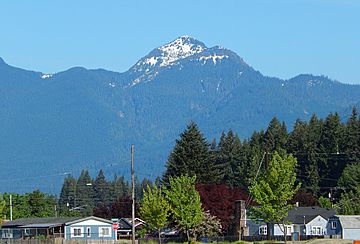Round Mountain (Washington) facts for kids
Quick facts for kids Round Mountain |
|
|---|---|

Round Mountain seen from Darrington
|
|
| Highest point | |
| Elevation | 5,320 ft (1,620 m) |
| Prominence | 4,780 ft (1,460 m) |
| Geography | |
| Parent range | Cascade Range |
| Topo map | USGS Fortson |
| Climbing | |
| Easiest route | Scrambling |
Round Mountain is a mountain peak in Washington state. It stands over 5,320 feet tall. You can find it on the western edge of the North Cascades mountains.
This mountain is located in Skagit County. It is about nine miles northwest of a town called Darrington, Washington. The land around Round Mountain is managed by the Mount Baker-Snoqualmie National Forest.
Round Mountain is special because of its "prominence." This means how much it rises above the land around it. Its prominence is 4,780 feet. This makes it the most prominent mountain in Skagit County. It is also the eighth most prominent mountain in all of Washington state. The closest taller mountain is Whitehorse Mountain. It is about 7.85 miles (12.63 km) to the south-southeast. Water from Round Mountain flows into streams that lead to the Stillaguamish River.
Weather Around Round Mountain
Round Mountain is in a "marine west coast" climate zone. This type of climate is found in western North America. It means the weather is often mild and wet.
Most weather systems, called weather fronts, start over the Pacific Ocean. They move northeast towards the Cascade Mountains. When these fronts reach the North Cascades, the tall peaks force the air upwards. This causes the air to cool and drop its moisture. This moisture falls as rain or snow onto the mountains. This process is called "orographic lift."
Because of this, the western side of the North Cascades gets a lot of rain and snow. This is especially true during the winter months. In winter, the sky is often cloudy. However, in summer, high-pressure systems over the Pacific Ocean become stronger. This often leads to clear skies and sunny weather.
How Round Mountain Was Formed
The North Cascades mountains have a very rugged landscape. They feature sharp peaks, long ridges, and deep valleys carved by glaciers. The way the land looks today was shaped by geological events that happened millions of years ago. These events created big changes in elevation. This led to different climates and types of plants in various areas.
The Cascade Range began to form millions of years ago. This was during a time called the late Eocene Epoch. The North American Plate (a huge piece of Earth's crust) was slowly moving over the Pacific Plate. This movement caused many volcanic eruptions.
Also, small pieces of Earth's crust, called "terranes," came together. These terranes helped create the North Cascades about 50 million years ago.
Later, during the Pleistocene period (over two million years ago), glaciers played a big role. Huge sheets of ice moved across the land many times. As they moved, they scraped away rock and left behind debris. The "U"-shaped valleys you see in the mountains today were carved by these glaciers. The combination of land being pushed up (uplift) and cracks in the Earth's crust (faulting), along with glaciation, created the tall peaks and deep valleys of the North Cascades.



